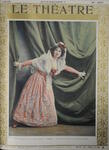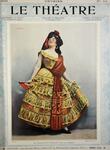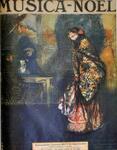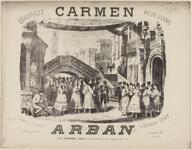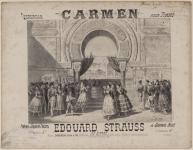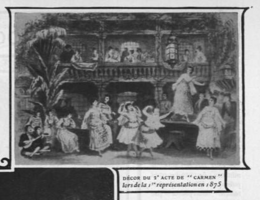Carmen
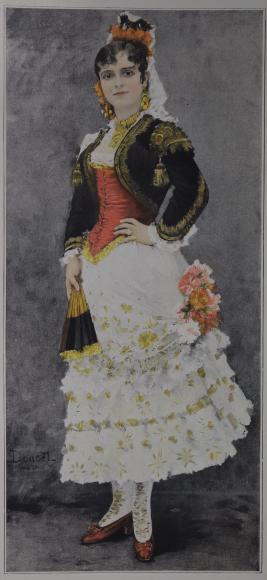
Opéra-comique en 4 actes, d'après Mérimée, créé à l'Opéra-Comique de Paris. Une version proposant des récitatifs (composés par Ernest Guiraud) à la place du texte parlé est créée à Vienne le 23 octobre 1875.
In 1875, after the première of Carmen on 3 March, Bizet's heroine was dismissed as a woman who has “sunk to the sewers of society”, a “veritable prostitute of the gutter and the street-corner” (Achille de Lauzières, La Patrie), a "wild animal" (Blaze de Bury, Revue des deux mondes), and a "cynical harlot" (Paul de Saint-Victor, Le moniteur); another critic spoke of “the uterine furies of Mlle Carmen and the lustings of the ribald crowd that throngs around her” (Oscar Comettant, Le siècle). The audience of the Opéra-Comique, Salle Favart, nevertheless found the conventions with which they were familiar: a picturesque setting (in defiance of ethnographic reality), bouffe elements, and strong, clear situations permitting distinctive arias, ensembles and choruses. With an amazing sense of effect combined with dazzling orchestral and harmonic refinement, Bizet had invented melodies that are now universally well known. But how was it possible to admit a tragic ending, a brigadier deserting from his military duties, and a cigarette girl freely choosing her lovers? In the “family theatre” of the Third Republic, the Gypsy girl was scandalous. Meilhac and Halévy's libretto based on Mérimée’s short story does not condemn Carmen – a role tailormade for its creator Célestine Galli-Marié. And the music goes further: it exalts her. No heroine enters in such a provocative manner as Carmen, with her habanera about the untameable nature of love, challenging the young men in the crowd, Don José, and also the theatre audience, with her “si tu ne m’aimes pas ...”, using the second person singular, the composer’s idea. Except in the solo in the middle of the “Trio des cartes”, when she realises that the cards are foretelling her death and receives the announcement with superb dignity, Carmen is constantly “playing to the gallery”, performing a part. One of the reasons why this Gypsy girl is so fascinating is that she embodies the irrepressible power of music and dance.
Videos
Scientific publications
Publication

